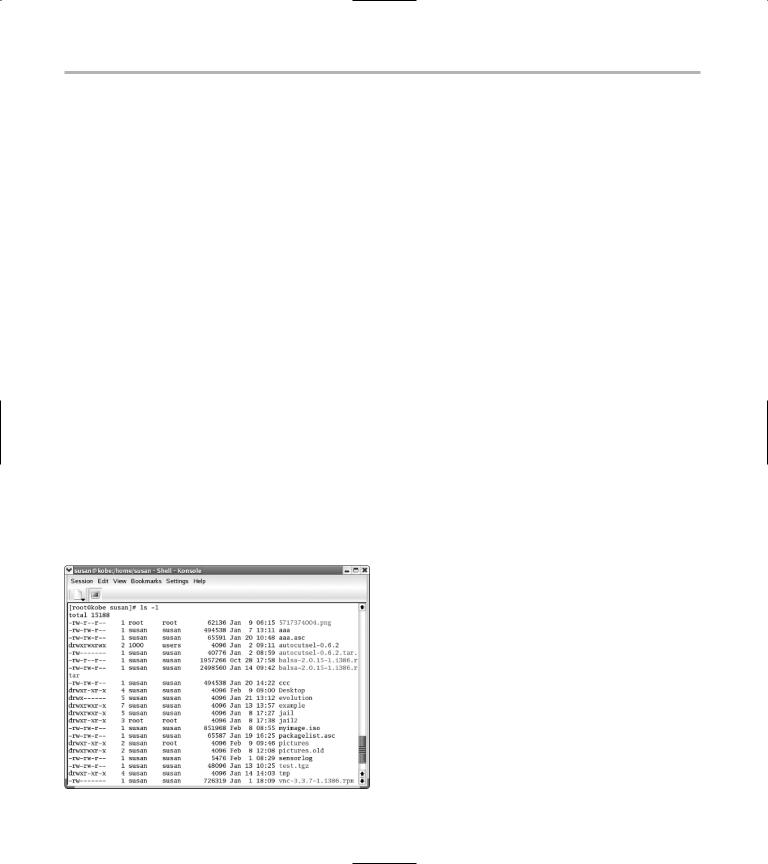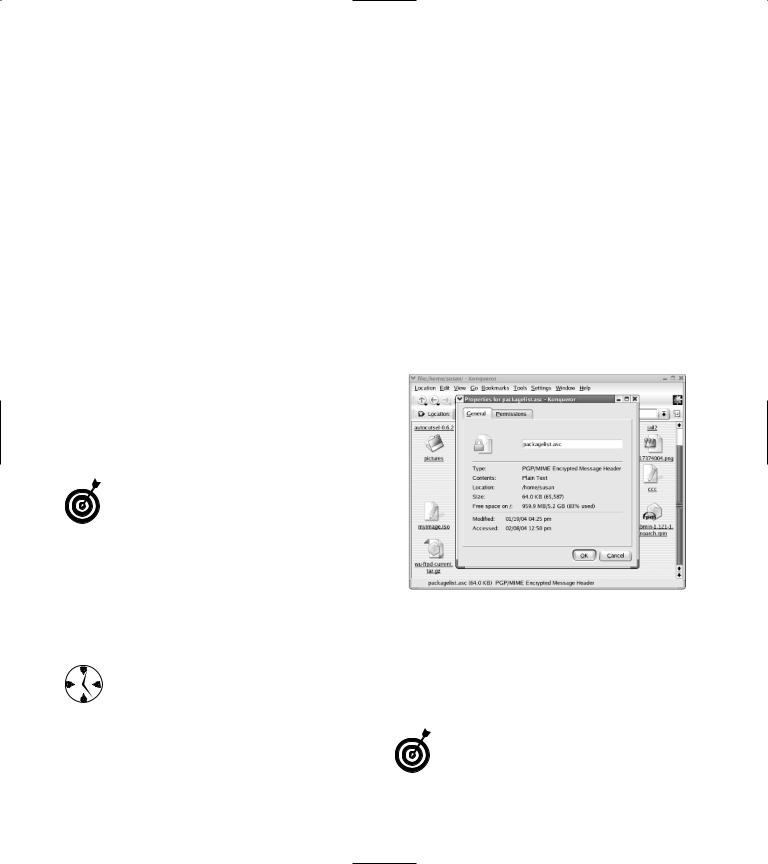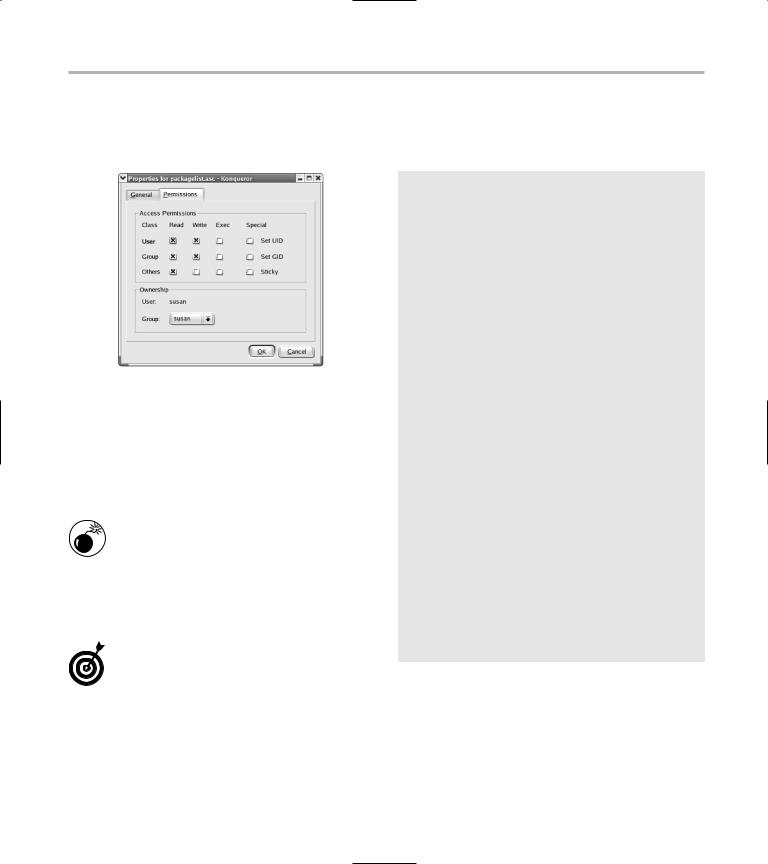
- •Table of Contents
- •Introduction
- •Saving Time with This Book
- •Foolish Assumptions
- •Part I: Making the Desktop Work for You
- •Part II: Getting the Most from Your File System
- •Part III: Good Housekeeping with Linux
- •Part IV: Tweaking the Kernel on Your Linux System
- •Part V: Securing Your Workspace
- •Part VI: Networking Like a Professional
- •Part VII: Monitoring Your System
- •Part VIII: Serving Up the Internet and More
- •Part X: Programming Tricks
- •Part XI: The Scary (Or Fun!) Stuff
- •Icons Used in This Book
- •Discovering Your Protocols
- •Managing Snapshots with the camera: Protocol
- •Remote File Management with fish:
- •Getting Help with help:, info:, and man:
- •Other KDE Protocols
- •Using GNOME VFS Modules
- •Stacking VFS Modules
- •Working with Packages: rpm and rpms
- •Putting VFS to Work at the Command Line
- •Burning CDs with a VFS
- •Skinning Your Desktop with VFS
- •Classifying Data with MIME
- •Creating KDE File Associations
- •Creating New MIME Types with GNOME
- •Making Basic Prompt Transformations
- •Adding Dynamically Updated Data to Your Prompt
- •Colorizing Your Prompt
- •Seeing a Red Alert When You Have Superuser Privileges
- •Saving Your Work
- •Completing Names Automatically
- •Using the Escape Key to Your Advantage
- •Customizing Completion for Maximum Speed
- •Using cd and ls to Navigate through bash
- •Setting Your CDPATH Variables to Find Directories Fast
- •Streamlining Archive Searches
- •Turning the Output of a Command into a Variable with $( )
- •Using $UID and $EUID in Shell Scripts
- •Customizing Variables for Rapid Transit
- •Finding the Right Shell Script
- •Choosing your victims
- •Timing is everything
- •Cleaning up made easy
- •Changing prototype scripts
- •Customizing Your Autostart File
- •Navigating the History List
- •Scrolling
- •Summoning a command by number
- •Searching through history
- •Customizing the History List
- •Adjusting key default settings
- •Filtering the history list
- •Executing Commands Quickly with History Variables
- •Viewing Your Aliases
- •Using Aliases for Complex Commands
- •Automating Tedious Tasks with Functions
- •Filtering file searches by file type
- •Automatic downloading
- •Monitoring Your System in a Snap
- •Un-tarring the Easy Way
- •What Is Samba?
- •Getting Up and Running with Samba
- •Checking whether Samba is installed
- •Enabling Samba
- •Adjusting the workgroup name and creating user accounts
- •Giving a Windows machine access to your home directory
- •Sharing Linux files and directories with other computers
- •Hooking Everyone Up to the Printer
- •Sharing Linux printers with SWAT
- •Using a Windows printer from Linux
- •Plugging In to Remote Data with Linux Programs Quickly
- •Finding Files with locate
- •Finding Files with find
- •Qualifying Your Search with the find Command
- •Doing updated filename searches
- •Adding time-based qualifications
- •Filtering by file size
- •Perusing commonly used qualifications
- •Acting on What You Find
- •Displaying specific info with -printf
- •Checking disk usage by user
- •Executing commands with find
- •Building Complex Commands with xargs
- •Creating Archives with File Roller
- •Inspecting and Extracting Archives with File Roller
- •Adding Functionality to tar with Complex Commands
- •Building archives from the command line
- •Archiving complex search results
- •Backing up an installed package
- •Uprooting Entire Directory Trees with scp
- •Splitting Big Files into Manageable Chunks
- •Building Software from Downloaded tarballs
- •Compiling a tarball: The basic steps
- •Downloading and compiling SuperKaramba
- •Versatile Downloading with wget
- •Mirroring sites with wget
- •Verifying your bookmarks with wget
- •Downloading files with wget
- •Downloading and unpacking in one quick step
- •Downloading and Uploading with curl
- •Setting Up ADIOS
- •Downloading ADIOS
- •Burning ADIOS to CD
- •Installing ADIOS
- •Finding Your Way around UML
- •Connecting to the Internet from an ADIOS VM
- •Using a GUI with UML
- •Installing Software into UML
- •Merging Changes to Your Prototype
- •Querying RPM Packages for Content
- •Digesting Information
- •Creating a Package Index
- •Querying for Prerequisites
- •Dissecting an RPM Package
- •Using RPM at the Command Line
- •Removing RPMs
- •Flagging Down RPM
- •Getting Graphic with RPM
- •Using Rpmdrake to install from media
- •Installing from your Konqueror browser
- •Verifying Your System
- •Reading the Tamper-Proof Seal
- •Setting Up Synaptic and apt in a Snap
- •Keeping Up-to-Date with apt and Synaptic: The Basics
- •Handy Hints about Synaptic
- •Changing repositories
- •Viewing package details
- •Installing new packages with Synaptic
- •Importing the Keys to the Repository
- •Letting Task Scheduler Work for You
- •Scheduling a new task
- •Editing a task
- •Adding environment variables
- •Reining In Resources with Disk Quotas
- •Installing the quota RPM package
- •Enabling file system quotas
- •Getting your files together
- •Setting quotas
- •Reviewing your quotas
- •Using System Accounting to Keep Track of Users
- •Setting up system accounting
- •Looking up user login hours
- •Checking out command and program usage
- •Running Down the Runlevels
- •Runlevel basics
- •Customizing runlevels in Fedora
- •Customizing runlevels in SuSE
- •Customizing runlevels in Mandrake
- •Customizing runlevels at the command line
- •Switching to a new runlevel
- •Disabling Unused Services
- •Removing Unneeded Services
- •Learning about modules
- •Installing a module with insmod
- •Taking care of dependencies automatically with modprobe and depmod
- •Loading a module for a slightly different kernel with insmod and modprobe
- •Removing modules with rmmod
- •Step 1: Making an Emergency Plan, or Boot Disk
- •Step 2: Finding the Source Code
- •Step 4: Customizing the Kernel
- •Step 5: Building the Kernel
- •Understanding the Principles of SELinux
- •Everything is an object
- •Identifying subjects in SELinux
- •Understanding the security context
- •Disabling or Disarming SELinux
- •Playing the Right Role
- •Exploring the Process-Related Entries in /proc
- •Surveying Your System from /proc
- •Popping the Cork: Speeding Up WINE with /proc
- •Reading and Understanding File Permissions
- •Controlling Permissions at the Command Line
- •Changing File Permissions from a Desktop
- •Encryption Made Easy with kgpg and the KDE Desktop
- •Creating keys with kgpg
- •Sharing your key with the world
- •Importing a public key from a public-key server
- •Encrypting and decrypting documents with drag-and-drop ease
- •Encrypting Documents with gpg at the Command Line
- •Sharing a secret file
- •Creating a key pair and receiving encrypted documents
- •Encrypting documents on your home system
- •Encrypting E-Mail for Added Security
- •Encrypting with Ximian Evolution
- •Setting up Mozilla e-mail for encryption
- •Sending and receiving encrypted messages with Mozilla mail
- •Using Cross-Platform Authentication with Linux and Windows
- •Prepping for cross-platform authentication
- •Setting up cross-platform authentication
- •Using PAM and Kerberos to Serve Up Authentication
- •Establishing synchronized system times
- •Testing your domain name server (DNS)
- •Setting up a Key Distribution Center
- •Setting up automatic ticket management with Kerberos and PAM
- •Adding users to the Key Distribution Center
- •Building Good Rules with PAM
- •Phase
- •Control level
- •Module pathname
- •Arguments
- •Dissecting a Configuration File
- •Skipping a Password with PAM
- •Feeling the Power
- •Gaining Superuser Privileges
- •Pretending to Be Other Users
- •Limiting Privileges with sudo
- •Installing sudo
- •Adding Up the Aliases
- •Adding Aliases to the sudo Configuration File
- •Defining the Alias
- •Creating a User_Alias
- •Creating a Runas_Alias
- •Simplifying group managment with a Host_Alias
- •Mounting and unmounting CDs without the superuser password
- •Managing access to dangerous commands with command aliases
- •Using SSH for Top-Speed Connections
- •Setting Up Public-Key Authentication to Secure SSH
- •Generating the key pair
- •Distributing your public key
- •Passing on your passphrase
- •Logging In with SSH and Key Authentication
- •Starting from the command line
- •Getting graphic
- •Creating Shortcuts to Your Favorite SSH Locations
- •Copying Files with scp
- •Secure (And Fast) Port Forwarding with SSH
- •Finding Your Firewall
- •Setting up a simple firewall in Mandrake Linux
- •Setting up a simple firewall in Fedora Linux
- •Setting up a simple firewall in SuSE Linux
- •Editing the Rules with Webmin
- •Starting a Webmin session
- •Reading the rules with Webmin
- •Changing the rules
- •Editing existing rules
- •Adding a new rule with Webmin
- •Sharing Desktops with VNC
- •Inviting Your Friends to Use Your Desktop
- •Serving Up a New Desktop with VNC Server
- •Using tsclient to View Remote Desktops from Linux
- •Using tsclient with a VNC server
- •Using tsclient with an RDP server
- •Creating New VNC Desktops on Demand
- •Switching display managers in SuSE Linux
- •Switching display managers in Mandrake Linux
- •Connecting gdm and VNC
- •Exploring Your Network with lsof
- •Running lsof
- •Interpreting the lsof output
- •Reading file types
- •Discovering Network Connections
- •Other Timesaving lsof Tricks
- •Packet Sniffing with the Ethereal Network Analyzer
- •Starting Ethereal
- •Capturing packets
- •Applying filters to screen packets
- •Peeking in packets
- •Color-coding packets coming from your network
- •Getting Up and Running with Nessus
- •Installing programs Nessus needs to run
- •Installing Nessus
- •Adding a user to Nessus
- •Generating a certificate
- •Starting the daemon and the interface
- •Reading the grim results
- •Keeping Your Plug-ins Up-to-Date
- •Chatting in the Fedora Chat Room
- •Looking for Answers in the SuSE Chat Room
- •Processing Processes with procps
- •Using ps to filter process status information
- •Viewing ps output the way you want to see it
- •Making parent-child relationships stand out in a ps listing
- •Climbing the family tree with pstree
- •Finding processes with pgrep
- •Killing Processes with pkill
- •Killing Processes with killall
- •Closing Windows with xkill
- •Managing Users and Groups with the Fedora/Mandrake User Manager
- •Adding new users
- •Modifying user accounts
- •Adding groups
- •Filtering users and groups
- •Managing Users and Groups with the SuSE User Administrator
- •Adding new users
- •Modifying user accounts
- •Adding groups
- •Filtering users and groups
- •Adding and deleting log files from the viewer
- •Setting up alerts and warnings
- •Viewing your log files from SuSE
- •Monitoring your log files from SuSE
- •Customizing Your Log Files
- •Keeping an Eye on Resources with KDE System Guard
- •Finding and killing runaway processes
- •Prioritizing processes to smooth a network bottleneck
- •Watching your system load
- •Creating a new worksheet
- •Creating system resource logs
- •Displaying network resources
- •Using Synaptic to download and install Apache
- •Installing Apache from disc
- •Starting the Apache Service
- •Building a Quick Web Page with OpenOffice.org
- •Taking Your Site Public with Dynamic DNS
- •Understanding how dynamic DNS works
- •Setting up dynamic DNS
- •Updating your IP address
- •Installing the Fedora HTTP Configuration tool
- •Putting the HTTP Configuration tool to work
- •Watching Your Web Server Traffic with apachetop
- •Installing apachetop
- •Running and exiting apachetop
- •Navigating apachetop
- •Switching among the log files (or watching several at once)
- •Changing the display time of apachetop statistics
- •Accessing MySQL Control Center features
- •Viewing, managing, and repairing a database with the Databases controls
- •Putting the Server Administration controls to work
- •Adding a new user
- •Watching Your MySQL Traffic with mtop
- •Gathering all the packages that mtop needs
- •Installing mtop
- •Monitoring traffic
- •Building a MySQL Server
- •Installing the necessary packages
- •Starting the MySQL server
- •Replicating MySQL Data
- •Configuring replication: The three topologies
- •Setting up replication for a single slave and master
- •Choosing a Method to Back Up MySQL Data
- •Backing Up and Restoring with mysqldump
- •mysqldump backup options
- •Backing up multiple databases
- •Compressing the archive
- •Restoring a mysqldump archive
- •Making a mysqlhotcopy of Your Database
- •Archiving a Replication Slave
- •Taking Care of Business with MySQL Administrator
- •Installing MySQL Administrator
- •Starting MySQL Administrator
- •Choosing an SSL Certificate
- •Creating a Certificate Signing Request
- •Creating a Signing Authority with openssl
- •Creating a certificate authority
- •Signing a CSR
- •Exploring Your Certificate Collection with Mozilla
- •Introducing hotway
- •Getting Started with hotway
- •Setting Up Evolution to Read HTTPMail Accounts with hotway
- •Ringing the Bells and Blowing the Whistles: Your Evolution Summary Page
- •Installing SpamAssassin
- •Installing from the distribution media
- •Installing from RPM downloads
- •Starting the service
- •Fine-Tuning SpamAssassin to Separate the Ham from the Spam
- •Customizing settings
- •Saving your settings
- •Adding a New Filter to Evolution
- •Serving Up a Big Bowl of the RulesDuJour
- •Registering Your Address
- •Taming a Sendmail Server
- •Tweaking Your Configuration Files with Webmin
- •Serving up mail for multiple domains
- •Relaying e-mail
- •Using aliases to simplify mail handling
- •Deciding What to Archive
- •Choosing Archive Media
- •Tape drives
- •Removable and external disk drives
- •Removable media
- •Optical media (CDs and DVDs)
- •Online storage
- •Choosing an Archive Scheme
- •Full backups
- •Differential backups
- •Incremental backups
- •Incremental versus differential backups
- •Choosing an Archive Program
- •Estimating Your Media Needs
- •Creating Data Archives with tar
- •Backing up files and directories
- •Backing up account information and passwords
- •Targeting bite-sized backups for speedier restores
- •Rolling whole file systems into a tarball
- •Starting an Incremental Backup Cycle
- •Restoring from Backup with tar
- •Backing Up to CD (Or DVD) with cdbackup
- •Creating the backup
- •Restoring from a CD or DVD backup
- •Restoring from a disc containing multiple archives
- •Combining the Power of tar with ssh for Quick Remote Backups
- •Testing the ssh connection to the remote host
- •Creating a tar archive over the ssh connection
- •Backing up to tape drives on remote machines
- •Backing Up to a Remote Computer with rdist and ssh
- •Testing the ssh connection to the remote host
- •Creating the distfile
- •Backing up
- •Getting Started with CVS
- •Checking whether CVS is installed
- •Discovering what to use CVS for
- •Creating a CVS Repository
- •Populating Your Repository with Files
- •Simplifying CVS with cervisia
- •Installing cervisia
- •Putting files in your sandbox
- •Adding more files to your repository
- •Committing your changes
- •Browsing your log files
- •Marking milestones with tags
- •Branching off with cervisia
- •Using the libcurl Library (C Programming)
- •Uploading a File with a Simple Program Using libcurl
- •Line 7: Defining functions and data types
- •Line 14: Calling the initialization function
- •Lines 18– 21: Defining the transfer
- •Line 23: Starting the transfer
- •Line 26: Finishing the upload
- •Installing the Ming Library
- •Building a Simple Flash Movie with Ming
- •Examining the program
- •Compiling the program
- •Running the program
- •Building Interactive Movies with Ming
- •Examining the program
- •Compiling the program
- •Running the program
- •Doing the curl E-shuffle with PHP
- •Combining PHP with curl and XML: An overview
- •Checking out the XML file
- •Downloading and displaying the XML file with a PHP script (and curl)
- •Sending E-Mail from PHP When Problems Occur
- •Debugging Perl Code with DDD
- •Installing and starting DDD
- •Examining the main window
- •Reviewing and stepping through source code
- •Making Stop Signs: Using Breakpoints to Watch Code
- •Setting a breakpoint
- •Modifying a breakpoint
- •Opening the data window
- •Adding a variable to the data window
- •Changing the display to a table
- •Using the Backtrace feature
- •Using the Help menu
- •Making Fedora Distribution CDs
- •Downloading the ISO images
- •Verifying the checksums
- •Burning an ISO File to Disc at the Command Line
- •Finding the identity of your drive
- •Running a test burn
- •Burning the distribution discs
- •Burning CDs without Making an ISO First
- •Finding setuid quickly and easily with kfind
- •Finding setuid and setgid programs at the command line
- •Deciding to Turn Off setuid or setgid
- •Changing the setuid or setgid Bit
- •Who Belongs in Jail?
- •Using UML to Jail Programs
- •Using lsof to Find Out Which Files Are Open
- •Debugging Your Environment with strace
- •Investigating Programs with ltrace
- •Handy strace and ltrace Options
- •Recording Program Errors with valgrind
- •Hardening Your Hat with Bastille
- •Downloading and installing Bastille and its dependencies
- •Welcome to the Bastille
- •Addressing file permission issues
- •Clamping down on SUID privileges
- •Moving on to account security
- •Making the boot process more secure
- •Securing connection broker
- •Limiting compiler access
- •Limiting access to hackers
- •Logging extra information
- •Keeping the daemons in check
- •Securing sendmail
- •Closing the gaps in Apache
- •Keeping temporary files safe
- •Building a better firewall
- •Port scanning with Bastille
- •Turning LIDS On and Off
- •Testing LIDS before Applying It to Your System
- •Controlling File Access with LIDS
- •Hiding Processes with LIDS
- •Running Down the Privilege List
- •Getting Graphical at the Command Line
- •Getting graphical in GNOME
- •Getting graphical with KDE
- •Staying desktop neutral
- •Index

27 Closing Those
Prying Eyes
Technique
Save Time By
Reading and understanding file permissions
Limiting file permissions to block access to sensitive information
Setting user permissions with a browser
Keeping private documents out of the hands of snoops is easy with well-assigned permissions and good system administration practices.
In this technique, we explain how to use file permissions to limit access to sensitive documents and dangerous programs on a Linux machine. You can set the permissions either at the command line or with a graphical interface. If you have access to a graphical environment (either Konqueror or Nautilus will work), it’s definitely the friendlier way to go.
Reading and Understanding File Permissions
Knowing how to read and use file permissions is important for maintaining privacy in your file system. Limiting a user’s access is simple when you understand the permissions.
Every file and directory in a Linux computer is owned by one specific user and one specific group. When you try to access a file, you’re classified into one of three categories:
Owner: You’re the owner if your effective user ID is the same as the file’s owner.
Group member: You’re a member of the group if your effective group ID is the same as the file’s group.
Other: You’re an “other” if you’re not the owner and not a member of the group.
After you’ve been categorized, Linux looks at the permissions assigned to your category. For example, if you’re accessing a file owned by user freddie and you’re logged in as user freddie, Linux examines the owner permissions for that file (because you are the owner). If you’re not logged in as user freddie but you are a member of the group that owns the file,

180 Technique 27: Closing Those Prying Eyes
Linux examines the group permissions for the file. If you’re not the owner and you’re not a member of the file’s group, Linux examines the other permissions.
Next, Linux compares the permissions (owner permissions, group permissions, or other permissions) with the type of access you’re attempting. If you are the file’s owner and are trying to read the file, Linux checks the read bit in the owner permissions. If you’re trying to modify the file, Linux checks the write bit on the owner permissions.
You can control three types of access for each user category:
Read permissions grant (or deny) the right to read a file or to list the contents of a directory.
Write permissions control the right to change the contents of the file or directory.
Execute permissions control the right to run a program or script. If you’re accessing a directory, the execute permissions control whether you can access the files within the directory.
To display the permissions for an entire directory, enter ls -l at the command line. The -l flag forces ls to display permissions (and the file’s owner and group) along with the name of each file (see Figure 27-1).
The listing shows seven groups of information. From right to left, they are as follows:
File permissions
Link count
Name of the user that owns the file
Name of the group that owns the file
File size (in bytes)
Date and time the file was last modified
File (or directory) name
The file permissions are displayed as an odd collection of ten characters, with dashes replacing the privileges that are denied to that user category.
For the sake of dissection, we’ve chosen the following listing as an example:
drwxr-x--- 4 freddie acctg 65595 Jan 20 14:14 tables
The first letter in the permissions column doesn’t have anything to do with permissions. Instead, it tells you what kind of file you’re dealing with. The most common entries are d for directory or - for file. In our example, the d at the beginning of the listing indicates that it is a directory.
The next three-letter grouping tells you the access permissions for the file’s owner (user freddie, in this example). The letters rwx stand for read, write, and execute. freddie has full permissions to this directory.
The next three-letter grouping tells you the group privileges. In our example, r-x stands for read and execute. The acctg group isn’t allowed to change files in the directory.
The last three-letter group tells you the file permissions for any other user (not the owner and not a
• Figure 27-1: The long form of directory contents.

Controlling Permissions at the Command Line 181
member of the file’s group). In our example, the ---
means that anyone who isn’t a member of the acctg group or isn’t the file owner is denied all access to the file.
Controlling Permissions at
the Command Line
If you have access to a desktop environment, maintaining permissions is easy and quick with a browser. If you need to set permissions over an
SSH connection or for a dedicated server (without a desktop environment), you can use the command line to change ownership and file permissions.
See Table 27-1 for details on changing ownership permissions.
Use the chmod command to change the permissions for users, groups, or others. Table 27-2 explains how. The chmod command also works with the + (plus) and - (minus) signs to turn permissions on and off. Substitute the plus or minus sign for the equal sign in the command, and the permissions listed in the argument are turned on or off. A plus sign turns the listed permission on, and a minus sign turns it off.
TABLE 27-1: CHANGING OWNERSHIP PERMISSIONS
For example, the following command turns on read permissions for the user without changing any of the other permissions:
$ chmod u+r filename
This command turns off write permissions for a group:
$chmod g-w filename
This command turns off all permissions for nongroup users:
$ chmod o-rwx filename
You can see a pattern starting to form.
If you need to, you can use the command line to set privileges, but there is a friendlier way, as described in the next section.
If you really want to test the spin in your propeller, you can set the permissions with octal numbers. The process is a little cryptic, but if you’re inclined to try it, check out the info chmod page and follow the links to Note File Permissions Numeric Modes.
To Do This |
Use This Command |
Change ownership of a file or directory at the command line. |
$ chown username filename |
Change ownership of a directory and all the directories below |
$ chown -R username directoryname |
it (that is, just add the -R recursive flag). |
|
Change the group ownership of a file. |
$ chgrp groupname filename |
Change the group ownership of a directory and all |
$ chgrp -R groupname directoryname |
the directories below it. |
|
|
|

182 |
Technique 27: Closing Those Prying Eyes |
|
|
|
|
TABLE 27-2: CHANGING FILE PERMISSIONS |
|
|
|
|
To Do This |
|
Use This Command |
|
|
|
|
|
|
|
Change the user (owner) permissions to include read, write, |
$ chmod u=rwx filename |
|
|
|
and execute. |
|
|
|
|
Exclude a permission from the user. You do this by excluding it |
$ chmod u=rx filename |
|
|
|
from the command. For example, to assign read and execute |
(Note: w is excluded) |
|
|
|
privileges only, use rx. |
|
|
|
|
Set permissions for a group. Note that you substitute a g into the |
$ chmod g=rwx filename |
|
|
|
command. |
|
|
|
|
Set permissions for users who aren’t group members or an owner. |
$ chmod o=rwx filename |
|
|
|
Deny privileges to nongroup members who aren’t owners. |
$ chmod o= filename |
|
|
|
|
|
|
|
Changing File Permissions from a Desktop
Sometimes the command line is your only choice, but if you have access to a graphical interface, there’s a friendlier way to manage file permissions: the Konqueror browser.
Nautilus offers the same functionality to GNOME users. Double-click the Start Here icon on the desktop and surf along.
To view and modify file permissions with the Konqueror browser, follow these steps:
1. Click the Start Here or Home icon on your KDE desktop or taskbar.
2. When Konqueror opens, locate the file you want to modify.
You can navigate to the file you want to modify in one quick step by entering file:/pathname in the Location field to step directly into the directory that contains your file.
3. After you’ve located the file you want to work with, right-click the file and choose Properties from the pop-up menu.
The Properties dialog opens, as shown in Figure 27-2.
•Figure 27-2: The Properties dialog.
4.Click the Permissions tab.
The Permissions dialog opens showing the current permissions for the file (see Figure 27-3). The permissions dialog is easy to interpret and change.
If the check boxes and fields displayed on the window are disabled, you don’t have enough privileges to edit the permissions for that file. If you need superuser privileges to change permissions for a file or directory, open a terminal window and use the su command to gain

Changing File Permissions from a Desktop |
183 |
superuser privileges. Then type konqueror in the command line and press Enter to start a copy of the browser with your newly enhanced privileges.
•Figure 27-3: The Permissions dialog.
5.To change read, write, or execute privileges for the file or directory, simply check the boxes next to User, Group, or Others.
If a box is checked, the user (or group) has that permission. If the box is empty, that permission is denied.
Before you modify the check boxes in the Special column, make sure that you know what you’re doing; read the sidebar, “What makes a check box Special?” for details.
6. To change ownership, enter the new user or group owner in the appropriate field.
Nautilus users: Use the drop-down list boxes to choose from existing users and groups when you change the ownership of a file or directory.
7. After you make the necessary changes to the
Permissions dialog, click OK to save your changes and close the dialog.
What makes a check box Special?
Under the column header labeled Special, you see check boxes next to the labels Set UID, Set GID, and Sticky. These check boxes merit special consideration.
Set UID: When a Set UID bit is turned on for a program, your EUID (effective user ID) becomes the same as the program’s owner when you run the program. You also gain all the privileges of the program’s owner. In other words, if user freddie runs a Set UID program owned by user root, freddie has superuser privileges while that program is running.
Set UID affects programs only; it’s really not important for data files and directories. If you find a Set UID program, read the WARNING!
Warning: Set UID programs are potentially dangerous. Users can gain extra privileges by using files that grant them superuser privileges. See Technique 57 for information about preventing security breaches uncovered by the setuid and setgid bits.
Set GID: The Set GID bit works similarly to Set UID — anyone running the program gains all the privileges of the group.
When the Set GID box is checked for a directory, the files in that directory belong to that group regardless of who puts the files in the directory.
Sticky: Checking the Sticky box affects directories only. If this box is checked, you can’t remove (or rename) a file in that directory unless you’re the file owner.

28 Using Encryption
for Extra Security
Technique
Save Time By
Using kgpg in your desktop environment
Using gpg at the command line
Encrypting and signing e-mail with Evolution
Adding Enigmail security to Mozilla
This technique is all about privacy. Keeping private data private can save you a lot of headaches. Public-key cryptography provides a quick and easy way to safeguard e-mail messages and sensitive files.
Public-key cryptography involves two big numbers: a public key and a private key. When you create a key pair, you keep the private key to yourself and share the public key with anyone you wish. The numbers in a key pair are related in a fiendishly clever way: Data that you encrypt with the public key can be decrypted only with the private key, and data encrypted with the private key can be decrypted only with the public key (private decrypts public, public decrypts private).
If you encrypt a message with your friend’s public key, only your friend can decrypt it (because your friend has never shared his private key with anyone, even with you). Encrypt a message with your private key and send it to your friend: If he uses your public key to decrypt the message (and the result looks meaningful), he’ll know the message came from you. (Nobody else could have sent the message because it’s encrypted with your private key, and no one else knows your private key.) You can combine these techniques to encrypt and sign a message.
In this technique, we show you how to use gpg (the GNU Privacy Guard) at the command line for those cases where you need security but don’t have access to a desktop environment. You can use gpg to encrypt, decrypt, and sign e-mail messages. gpg can also encrypt documents that you don’t intend to share with others, so snoops won’t be able to read anything you need to keep private. Encrypt the original document, delete the unencrypted version, and only you can decrypt it again to read it.
kgpg (KGpg) is a graphical interface for gpg that runs in the KDE Desktop environment. It’s a great tool that packs lots of functionality into a userfriendly package. In this technique, we show you how to download, install, and use kgpg. We also show you how to create a gpg key pair (from the command line and with kgpg). After you’ve created a key pair, you can distribute your public key to your friends, or you can upload the public key to a server — a number of public-key registries are available on the Web.
